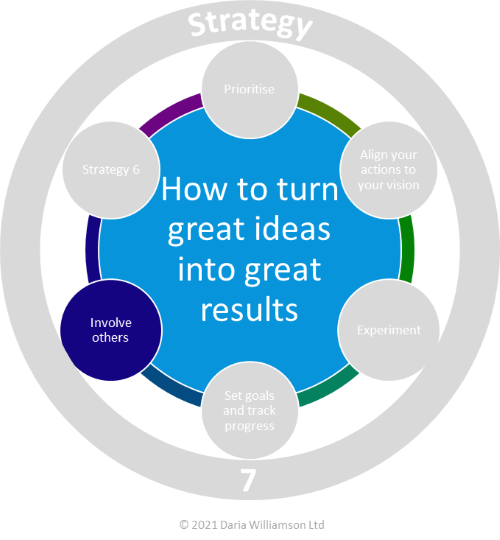If you’ve read through my previous series on how to have great ideas, ‘involve others’ will be a familiar strategy for you.
There’s an excellent reason for including it again in this series about converting great ideas into great results. Why? Because in most change efforts, we get better results together than we do alone.
Why it's so important to involve others
In my previous article, I talked about how essential it is for we humans to be connected with other people. It’s a built-in, life-long need, and when we approach it with the right mindset, we realise that this need can make life both easier and more interesting.
When it comes to generating great ideas, working with other people and involving them in our thinking boosts the quality and quantity of our ideas. And that helps us have great ideas.
A similar effect is found when we are implementing change – getting others on board will strengthen our improvement process.

Nine reasons to involve others in your implementation
Not only is involving others in change often required under labour laws, but it is clear that it is one of the key best practices of change management.
1. Involve others to see different perspectives
Building a change team can strengthen your change programme by introducing different perspectives. This can help identify staff attitudes and concerns, and recognise when information isn’t getting to the right people at the right time.
One key: you need to welcome and actively encourage discussion of these different perspectives. If everyone is always in agreement, you aren’t getting diversity of thought.
2. Involve others to incorporate diverse skills
No one has all of the skill required to implement complex changes. Getting a team together to execute the change means you get access to a broad range of skills, experience and capability, which will boost your chances of making successful change.
3. Involve others to grow their skills
And it’s not just about getting highly-skilled people on your change team – you can help people grow their skills by involving them in the change.
Look around you for people who have potential that is going unrealised – how can you engage them with the change, and provide opportunities for professional development?
4. Involve others to create buy-in
When people get the chance to hear about the change from those who want to make it, they can ask questions and learn about the motives, reasons, goals and strategies.
Being able to have a conversation about these things is a great start to creating buy-in, which is vital if you’re relying on them to implement the change. And in conversation, you’ll often learn things you didn’t know which will make the change even more effective.
In addition, the people on your change team will be educating people in their networks about the value of the change, which helps speed up communication around the change. It also increases the credibility, as we are more likely to accept messages when they come from people we know and like.
Check out the the Resources section for links to information on common reasons that people resist change.
5. Involve others to expand your leadership influence
Involving others in implementing successful change will enhance your reputation as a leader, expanding your influence, which means you can accomplish more.
People talk, and they really notice when they and others are included, acknowledged and appreciated. So, when a new idea bubbles up, who will they bring it to?
6. Involve others to prevent mistakes
Approaching change as a team puts more brains on the job. This increases the chance someone will spot a mistake before it happens, or catching it before it snowballs.
It’s not 100% foolproof, but it does tilt the odds significantly in your favour.
7. Involve others to enhance resilience
Most of us still battle with hero syndrome. We want to be the one who single-handedly fixes all the problems and makes everything perfect. The problem with being a lone ranger is that if anything happens to us, the change effort falls flat.
Involving others makes the change programme resilient – the wheels will still keep turning, even if we hae to step away for a day, a week, or longer.
8. Involve others to show respect and trust
Adults hate being treated like children. Imposing change from above without consultation or an opportunity to provide input and feedback means you lose the opportunity to access their experience, knowledge and insights. This can create resentment, and lead to disengagement, if not turnover.
Sincerely asking for and considering feedback and input, even if you ultimately end up choosing a different direction, demonstrates respect for team members and a trust in their capability.
9. Involve others to generate new change opportunities
You might be familiar with the concept of the Johari window. It’s a way of categorising what we and others know – it’s often used in relation to how well we know ourselves.
However, it can also be used to think about knowledge more broadly. The “Blind” quadrant is the biggest area of opportunity, because there will be change ideas that others are aware of that are outside your notice.

Involving other people in your change programme can get you access to those ideas, which can improve your outcomes dramatically.
Involving others isn't a silver bullet
While there are many positive reasons for involving others in your change, it doesn’t mean that your change will sail through without any hitches.
Whenever humans are involved, there will always be hiccups, delays and complications. But by getting the right people on board early, listening to and incorporating their feedback, and sharing the ups and downs of the implementation with them, you dramatically increase your chances of success.
Progress check
This article is part of the series, ‘How to turn great ideas into great results’. The strategy articles so far are:
- Prioritise
- Align your actions with your vision
- Experiment
- Set goals and track progress
- Involve others (this article)

Stay tuned for the next article covering the next strategy for turning your great ideas into great results. You can keep an eye on the series page for new articles, or sign up to my weekly newsletter below to be the first in the know when a new article is published.
If you’d like to learn more about generating ideas, check out the companion to this series, ‘How to have great ideas‘. It has ten science-backed strategies to help you generate great ideas.
Get your own great results
I help people to identify their strengths and capabilites, and use them to achieve their goals and dreams.
If you want to turn your great ideas into great results, I would love to help. I offer complimentary discovery calls – book yours on my Bookings page, send a message via my Contact page, or email me.
Resources
- What are the Benefits of Employee Participation in Change Management? – Change Management Insight
- Workplace change process outline – Employment New Zealand
- Engaging employees through change – Business Queensland
- Understanding Why People Resist Change – Prosci.com
- 5 Ways To Empower And Engage Employees To Lead Change – Forbes




1 thought on “Great results: Strategy 5 – involve others”
Pingback: How to turn great ideas into great results: Strategy 7 – use your strengths ~ Daria Williamson
Comments are closed.